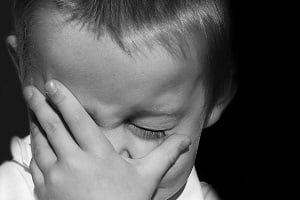GERD in Children and Babies
- Updated on: Jul 2, 2024
- 5 min Read
- Published on Nov 27, 2019

GERD is a disease characterized by heartburn, chest pain, and indigestion after taking a large meal or some spicy food. This disease occurs due to acid reflux from the stomach into the esophagus. GERD does not only affect adults, but children can also have it due to their unhealthy eating habits.
How Does GERD Affect Children and Babies?
GERD is a digestive system disease in which the stomach contents reflux into the esophagus (food pipe) and leads to many symptoms. Apart from adults, GERD is also common in children and babies. Babies affected by GERD often vomit milk after they are fed. Children and teens suffering from GERD often experience heartburn, sore throat, discomfort, burping, bad taste, and irritation. GERD in children and babies should not be avoided as it may interfere with their normal growth and functioning. Besides, it may cause other complications, such as painful ulcers and esophagus inflammation (esophagitis).
What Are the Symptoms of GERD in Children and Babies?
Children affected by GERD usually show the following symptoms:
- Frequent vomiting
- Recurrent coughing
- Sour taste
- Chest pain
- Heartburn
- Belching
- Coughing
- Hiccups
- Burping
- Wheezing
- Sore throat in the morning
- Abdominal pain
- Recurrent pneumonia
- Bad breath
- Loss or enamel or tooth decay
Read Acid Reflux and Pregnancy
What Are the Causes of GERD in Children and Babies?
The cause of GERD in children and babies is the same as in adults. GERD mainly occurs when the lower esophageal sphincter (LES) becomes weak. The LES is present at the esophagus base and opens towards the stomach while swallowing and then gets closed. Increased acid production in the stomach weakens the LES muscles, due to which it remains relaxed. As a result, the acidic contents of the stomach backflow into the esophagus leading to GERD.
Generally, GERD in children and babies may be due to poor functioning of the digestive system. However, some studies suggest that it may be due to improper functioning of the brain and muscles. Some children with GERD in their early childhood are more prone to it when they are grown-up teens. In some cases, GERD can be inherited from parents.
Besides the above-mentioned causes, some other factors responsible for GERD in children and babies are:
- Obesity
- Overeating or overfeeding of milk
- Eating spicy and fried foods
- Eating more snacks
- Some medications
- Eating chocolates
- Carbonated drinks
Diagnosis of GERD in Children and Babies
GERD’s diagnosis in children and adults is mainly based upon the signs and symptoms of the disease. The doctor will ask about any medical history and inquire about the child’s dietary habits. Besides, the following tests may be recommended for the diagnosis of GERD:
Chest-X-ray
The doctor may perform an X-ray of your child’s chest to check whether stomach content has refluxed towards the esophagus.
Barium Swallow
The test is performed to check the upper digestive system’s parts, including the esophagus, stomach, and small intestines. In this test, the patient is given barium for swallowing orally. The barium coats different organs, and then X-ray imaging is done to check the ulcers or inflammation in the organs.
Endoscopy
In this procedure, a thin and flexible tube-like structure is inserted into the mouth of your child to check the internal side of the digestive tract. This tube is called an endoscope, and it has a camera at its end. After the procedure, a tissue sample is collected for further tests.
Esophageal Manometry
Esophageal manometry is performed for checking the strength of esophageal muscles. It helps in analyzing whether your child is having a problem swallowing or not. A tube is threaded inside the nostril, moving down the throat and then pushed down the esophagus to measure the pressure that esophageal muscles create at rest.
pH Monitoring
This test is done to check the pH level of your child’s esophagus. In this test, a thin tube is placed through your child’s nostril guided down the throat into the esophagus. The other end of the tube that is present outside the body is connected to a monitor for recording the pH level for 24-48 hours. During this procedure, the child can perform all normal activities and record GERD symptoms like coughing, vomiting, and gagging. The pH levels are evaluated in this period and compared with the child’s activities during that period.
Gastric Emptying Study
This test is performed to determine if your child’s stomach can properly release its contents into the small intestine. Delayed gastric emptying can lead to reflux of stomach contents into the esophagus.
Read Posture Effects on Your GERD Symptoms
How Can GERD Be Cured in Children and Babies?
GERD in children and babies can be cured by making some lifestyle modifications to ensure no reflux of acid. Following are some of the lifestyle modifications that can be helpful:
For Babies:
- Hold your baby in an upright position for 30 minutes after feeding.
- Keep the nipple of the bottle filled with milk so that your baby does not swallow excess air while feeding.
- Add rice cereal to your baby’s milk.
- Always make your baby burp after milk feeding.
- Elevate your baby’s head up while sleeping
For Older Children:
- Shift your child’s sleeping position towards the left side.
- Make sure your child is properly.
- Elevate the head of your child while sleeping.
- Don’t allow your children to have fried and spicy foods, cold drinks, caffeinated drinks, etc.
- Encourage your children to perform daily exercises.
If the above-mentioned lifestyle modifications do not serve the purpose, your doctor may recommend some GERD medications that will decrease the acid content of your child’s stomach. Some of these medications include:
- Antacids such as Maalox and Mylanta
- Proton-pump inhibitors such as Prilosec, Prevacid, Aciphex, Protonix, Nexium and Zegerid
- Histamine-2 or H2 blockers such as Pepcid, Zantac and Axid
High doses of these drugs in your child may cause side-effects such as diarrhea, stomach ache, constipation, bloating, nausea, and gas. Long-term use of antacids may lead to thinning of bones.
If the medications are also not useful against GERD, it may be recommended to go for surgery (which is rare in children and babies). Surgery is recommended only in severe cases of GERD. Fundoplication is one of the procedures that may be performed in severe GERD symptoms. In this procedure, the top part of the stomach is wrapped around the esophagus, forming a cuff that contracts and closes the esophagus whenever the stomach causes contraction. This prevents acid reflux. Although this procedure seems to be effective, it can also be risky. Before going for this procedure, you should discuss the benefits and risks with your child’s pediatrician.
FAQs
Can a Child Get GERD?
Yes, a child can get gastroesophageal reflux disease (GERD). GERD can occur at any age and is most common in children. In infants, GERD can cause vomiting after feeding. It can cause other problems also like poor growth, coughing, frequent pneumonia, and coughing.
Can a Baby die From Reflux?
No, a baby cannot die from reflux. Babies suffering from acid reflux have vomiting and cough when they swallow anything. They will show more symptoms like frequent cold, hiccups, bulching and belching. Severe complications of GERD may include esophageal inflammation and ulcers in the esophagus (food pipe).
Can a 7 Year Old Have Acid Reflux?
Yes, a 7 year old child may get acid reflux. Child can experience heartburn and chest pain that are the common symptoms of GERD. According to a study, it has been been estimated that 2% of children of age group 3-9 years and 5 % of children of age group 10-17 years suffer from acid reflux.
What Treatments Might the Doctor Give for my Child's GERD?
Your doctor may prescribe some medications to your child to reduce the symptoms of GERD:
- Antacids such as Mylanta and Maalox, to neutralize the stomach acid.
- H2 blockers such as zantac and pepcid, to decrease the acid production in the stomach
- Proton pump inhibitors such as Prevacid, prilosec and Aciphex, to reduce the acid secretion in the stomach












